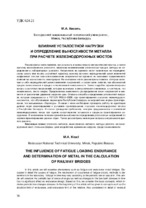| dc.contributor.author | Кисель, М. А. | ru |
| dc.coverage.spatial | Пермь | ru |
| dc.date.accessioned | 2018-10-01T12:46:55Z | |
| dc.date.available | 2018-10-01T12:46:55Z | |
| dc.date.issued | 2015 | |
| dc.identifier.citation | Кисель, М. А. Влияние усталостной нагрузки и определение выносливости металла при расчете железнодорожных мостов / М. А. Кисель // Транспорт. Транспортные сооружения. Экология. – 2015. – № 1. – С. 56-68. | ru |
| dc.identifier.uri | https://rep.bntu.by/handle/data/47912 | |
| dc.description.abstract | Рассмотрены такие явления, как усталость и выносливость металлических мостов, а также причины возникновения усталости, механизм возникновения усталостных трещин, методы ее определения в лабораторных условиях. Напряжения во времени могут изменяться по периодическому закону или носить случайный характер, поэтому изложен периодический закон изменений напряжений, так как сам закон изменения напряжений во времени не оказывает существенного влияния на выносливость конструкции. На основании этого рассмотрены понятия, которые включает в себя периодический закон изменения напряжений, а также такие понятия, как абсолютный предел выносливости и предел относительной выносливости. Также подробно проанализирован вопрос остаточных напряжений, которые возникают в металлических элементах, в том числе, что немаловажно, после сварки. Представлена зависимость распределения таких напряжений в элементе от расстояния удаления сварного шва. Описаны способы определения усталостной нагрузки, которые предлагаются в ТКП EN 1993-2-2009, при проектировании стальных железнодорожных мостов, что обусловлено переходом Республики Беларусь на европейские нормы проектирования, так называемые «Еврокоды». В связи с этим необходимо проводить работу по адаптации данных норм проектирования к условиям проектирования стальных железнодорожных мостов в Республике Беларусь. В статье приведены требования, которые предъявляются к элементам железнодорожного моста при оценке сопротивления усталости в процессе проектирования сооружения. В заключение показан сравнительный анализ определения усталостных напряжений по нормам проектирования разных стран. Также рассмотрены некоторые вопросы актуальности данного расчета. | ru |
| dc.language.iso | ru | ru |
| dc.publisher | Пермский национальный исследовательский политехнический университет | ru |
| dc.title | Влияние усталостной нагрузки и определение выносливости металла при расчете железнодорожных мостов | ru |
| dc.title.alternative | The influence of fatigue loading endurance and determination of metal in the calculation of railway bridges | en |
| dc.type | Article | ru |
| local.description.annotation | In this article we will examine phenomena such as fatigue and endurance metal bridges. Discussed in detail the causes of fatigue, the mechanism of occurrence of fatigue cracks, methods to determine it in the laboratory. Voltage in time may vary according to the periodic law or casual in. This article will consider the periodic law of stress changes as well as changes in the law itself stresses in time has no significant effect on endurance design. Based on this, we consider the basic concepts, which includes periodic law changes stresses. In the beginning of the article will be given to concepts such as the absolute limit of endurance, and endurance limit of the relative. Also considered in detail of residual stresses which occur in metal elements, and not least, the residual stresses which occur in metal elements after welding. The dependence of the distribution of stresses in the element on the distance remove weld. Learn how to determine the fatigue loading, which are offered in TAP EN 1993-2-2009, in the design of steel railway bridges. The reason for consideration of the matter by European standards served as the transition of the Republic of Belarus to the European design standards, so-called "Eurocodes". In this regard, it is necessary to work on the adaptation of these rules to the conditions of the design design of steel railway bridges in the Republic of Belarus in the materials of the article the requirements that apply to the elements of the railway bridge in the assessment of fatigue resistance in the process of designing structures. Finally, a comparative analysis shows the determination of a fatigue design rules for different countries. Also addressed some questions the relevance of the calculation. | en |

